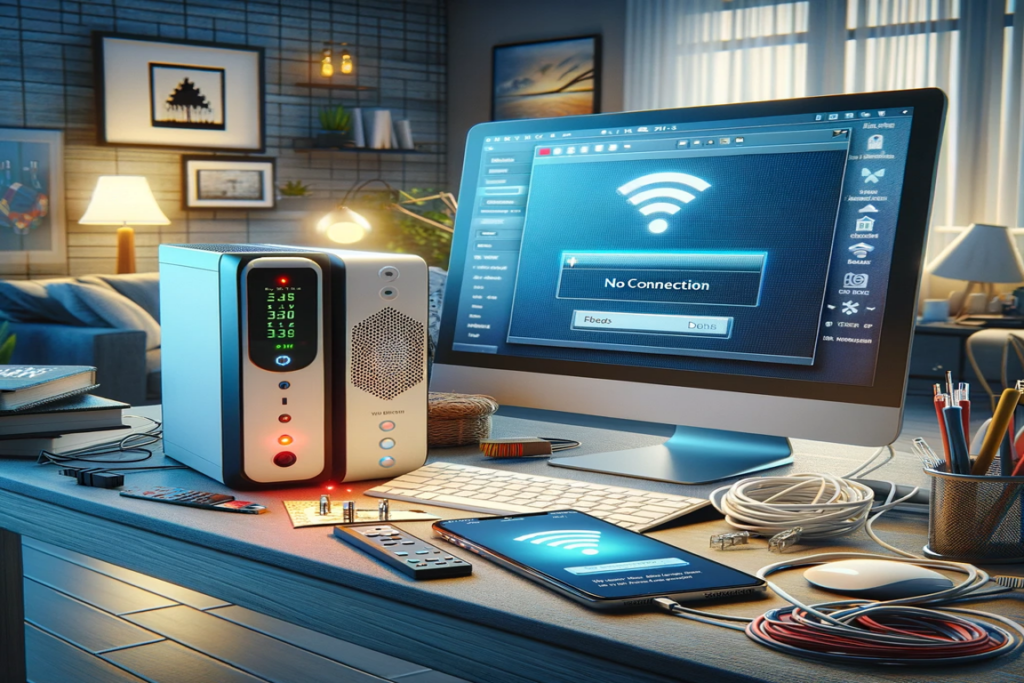
A failed internet connection can be disastrous for any professional business, exposing it to lost productivity, revenue, and customer complaints. The cost of internet downtime can be exorbitant. A few minutes of downtime due to Wi-Fi or internet connectivity issues can have a significant impact on your company’s bottom line.
Because of these potential consequences, you must arm yourself with the necessary skills to troubleshoot and address the issue head-on.
Can’t access the internet? If your internet is down, use these network troubleshooting tips to get it back up and running.
All of these steps may seem cliche and pointless to you, but any specialized IT engineer should go through them first in order to get the issue fixed.
Table of Contents
ToggleCan’t connect to the internet?
Here are 9 Troubleshooting Techniques.
1. Check for Physical Connectivity Issues
A loose or unplugged network cable, modem, or router, for example, can cause an internet connection to fail. If you’re connected to a wireless network, your computer’s wireless network interface card may be disabled. First, check your Wi-Fi settings by going to Settings > Network & Internet > Wi-Fi and then turning Wi-Fi on. Check the settings that turn Wi-Fi on and off on your phone or tablet and make sure it’s turned on.
Check the Ethernet cables that connect to your router for wired connections. If you suspect that a cable is a problem, try replacing it or switching ports.
2. Restart the Router
Restarting the router can occasionally help resolve internet connectivity issues. If your router has been turned off for an extended period of time, a quick restart may be all that is required to get it back up and running.
The hardware and software components of a router or modem are prone to malfunctioning for a variety of reasons. Similarly, your computer should be restarted every now and then to refresh running processes and clear the cache.
Rebooting your router can help, but if you have to do it every day or multiple times a week to resolve connectivity issues, you may need to replace your modem or router. In this case, you may need to contact your local ISP.
3. Evaluate Software Problems
Your connectivity issues could be caused by strict firewall rules or security policies. Many new-generation antivirus solutions, such as Norton and Malwarebytes, include network intrusion protection, which functions as a software firewall, filtering and blocking malicious traffic.
When two software firewalls, such as Windows Firewall and a private, third-party firewall, are installed on the same computer, the contention between the two can incorrectly block traffic. If you recently installed or upgraded a firewall on your computer, consider temporarily disabling it to see if it’s the source of the connection problem.
4. Check If You’re Outside the Wireless Signal Range
If you’re using a Wi-Fi network, you should be aware that the distance between your wireless access point and your device affects connection performance. The further you move away from the Wi-Fi router or a wireless access point, the slower the internet connection becomes, and any further drift results in a complete breakdown. Signal interference in your area can also limit the Wi-Fi connection’s effective range.
5. Check Service Isn’t Being Blocked
Internet Service Providers (ISPs) may decide to block access to your account if you do not pay or violate the provider’s Terms of Service. It’s easy to forget to keep your subscription updated if you use paid hotspots that charge hourly or daily.
Your ISP may also block your account if you exceed bandwidth limits, download illegal or inappropriate content, or send spam emails. Most internet service providers will notify you by default when you attempt to access a webpage if your account has been suspended; however, it is always a good practice to contact your ISP as soon as possible if you suspect your account has been suspended.
6. Open Windows Network Diagnostics and Check Your DNS settings
Windows includes a tool called Windows Network Diagnostics that allows users to troubleshoot internet connection issues. Simply navigate to Windows Settings > Network & Internet > Status to get started. Next, navigate to Network Settings and select Network Troubleshooter.
The Windows Network Diagnostics tool will then run a few tests to see what’s causing your internet connection problems. If an issue is discovered, Windows will provide you with a list of possible solutions to restore your connection.
Many SoHo (Small office/Home office) routers use themselves as DNS servers by default; however, many cheaper devices are not designed for the CPU stress that the DNS service can apply to the device; therefore, it is best practice to manually replace the primary and secondary DNS servers in your NIC (Network Interface Card) configuration with Google DNS (8.8.8.8 and 8.8.4.4).
7. Reboot the Computer
Failures in the operating system software that controls the adapter are common.
This is why it is always a good idea to restart your computer; by doing so, you can clear the cache and ensure that the settings do not revert to previous configurations.
This happens all the time. Sometimes, after making all of the necessary changes, we expect the solution to work, but it does not. The fixes are only applied after the computer has been restarted.
8. Contact Your Internet Service Provider
If you use satellite internet, you may notice that the connection is less reliable during extreme weather. In densely populated urban areas, internet service providers or cellular internet carriers may be unable to support network traffic peaks, resulting in sporadic outages for some users. If you can’t figure out why you can’t connect to the internet, your ISP should be able to help.
9. Reach Out to IT Professionals
Finally, if you’ve tried everything and your internet connection still won’t restore, it’s best to contact a professional IT support team to troubleshoot your problem and restore your connection before the downtime has a negative impact on your operations. Although there may be a service fee involved, it is worthwhile at the end given the potential loss of business and man-hours.
When your company partners with PyramidBITS, our team of IT experts can diagnose and troubleshoot your connectivity issues.
Also, Read
- IT Industry & How Has Egypt Moved 5 Steps Forward To Take The Lead?
- 7 Reasons Why ‘Remote IT Support’ is Very Crucial?
- 6 Benefits of Having a High-Quality IT Support Department
- IT Solutions – The Invisible Helping Hand, Now Meeting Number 1 Trends in Egypt
- 6 Steps to Prevent Network Security Threats
- 2 Tools for Hiring The Right Talent
- Why HR & IT Alignment Is Important in 6 Aspects?




